Since Bev Preistman became manager of the Canadian women’s national team, success has followed. The 37-year-old England native led Canada to the gold medal at the Tokyo Olympics in 2021, as well as finishing as runners-up to the United States in the 2022 CONCACAF Women’s Championships.
The former England women’s assistant under Phil Neville was hired in 2020, meaning she was not manager during the 2019 Women’s World Cup in France, where the side fell to Sweden in the first knockout stage. Priestman will hope that she can take Canada further, by bringing a rather experienced squad to this tournament in Australia and New Zealand, one that will likely be the last World Cup for many on this roster, including 40-year-old captain, top goalscorer, and most capped player, Christine Sinclair.
Predicted starting XI
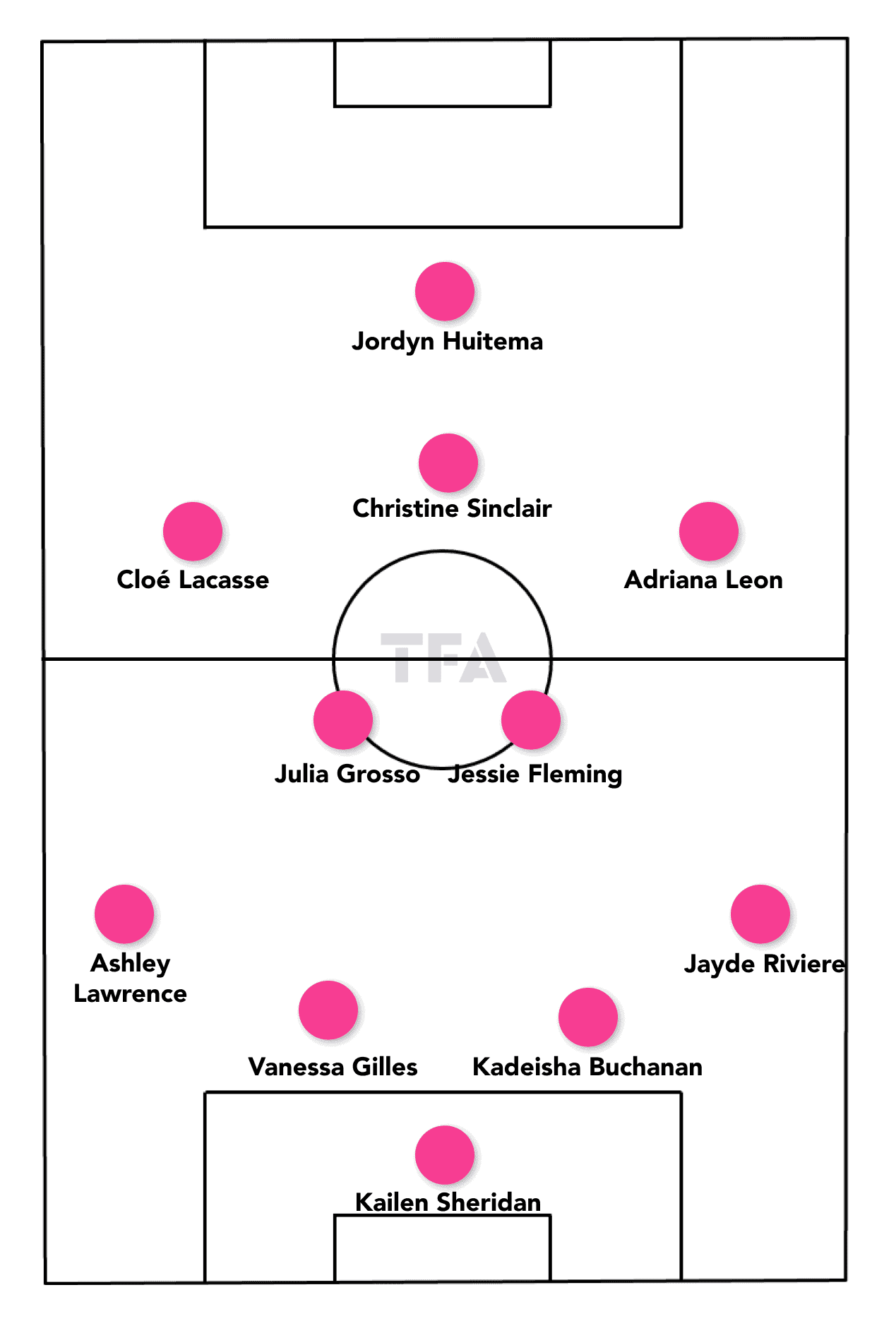
The image above shows what Bev Preistman may opt to start with for Canada’s first group-stage match against Nigeria. In goal will likely be Kailen Sheridan, with the 27-year-old San Diego Wave goalkeeper becoming Canada’s new number one after the retirement of Stephanie Labbé. In the full-back positions, we expect Canada to start with Paris Saint-Germain full-back Ashley Lawrence on the left side, with 22-year-old Manchester United full-back Jayde Riviere on the right. Priestman has a few solid centre-back options to choose from, but her preferred pairing will likely be Vanessa Gilles alongside Chelsea central defender Kadeisha Buchanan.
Moving into midfield, expect Julia Grosso and Jessie Fleming to start as the double-pivot, as Bev Preistman has favoured these two playing alongside each other in recent matches. Further forward, captain Christine Sinclair will likely start in a deeper ‘number 10’ role, giving her more freedom and not having to worry as much about tracking back. Adriana Leon will likely start on the right side of the attacking midfield, with it potentially being a toss-up between either Cloé Lacasse and the just back-to-fitness Nichelle Prince, but it may be too soon for Prince to start when the World Cup begins.
Finally, up top is a position where Priestman could go a few different ways, but we think that Jordyn Huitema is who the 37-year-old will likely turn to in the first group-stage match against Nigeria. The 22-year-old has had a decent start to the NWSL season with OL Reign with six goals in 13 appearances in all competitions, and Priestman will be hoping she can carry some of this form over to the international stage when Canada kicks off in the 2023 FIFA Women’s World Cup.
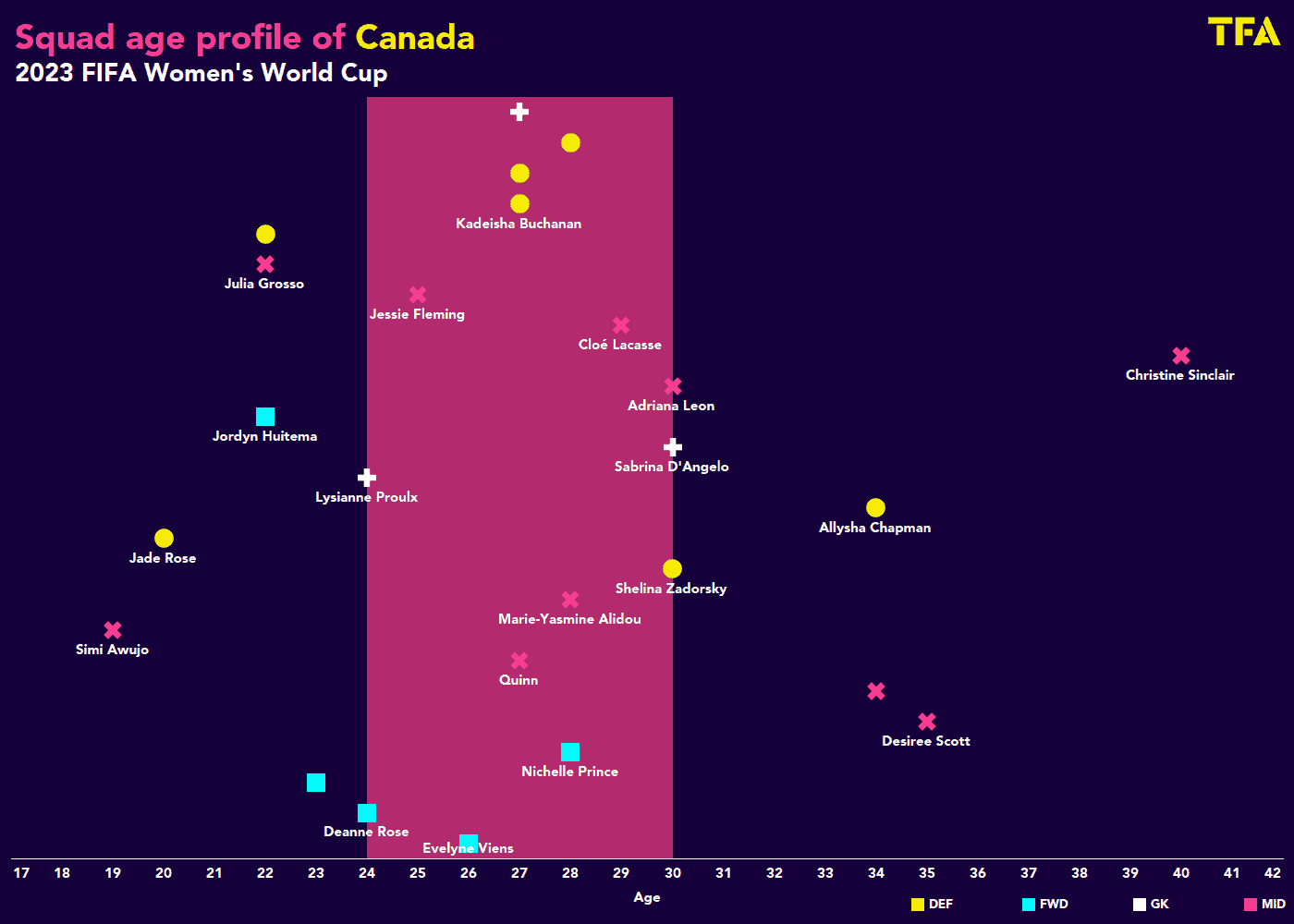
The graphic above shows the preliminary squad that Bev Priestman has chosen for Canada going into this World Cup, with this image also showing the age profile of the Canadian squad. As we can see, the average squad age falls at around 27 or 28, highlighting the experience that Priestman will have at the World Cup. Out of the likely starting XI, only two, Huitema and Grosso, are 22 or younger, with the majority of the Canadian likely starters being 25 or older. Going into her first World Cup in charge of Canada, the 37-year-old manager will hope that the experience in the squad pays dividends and helps Canada progress deep into this tournament.
Attacking phase
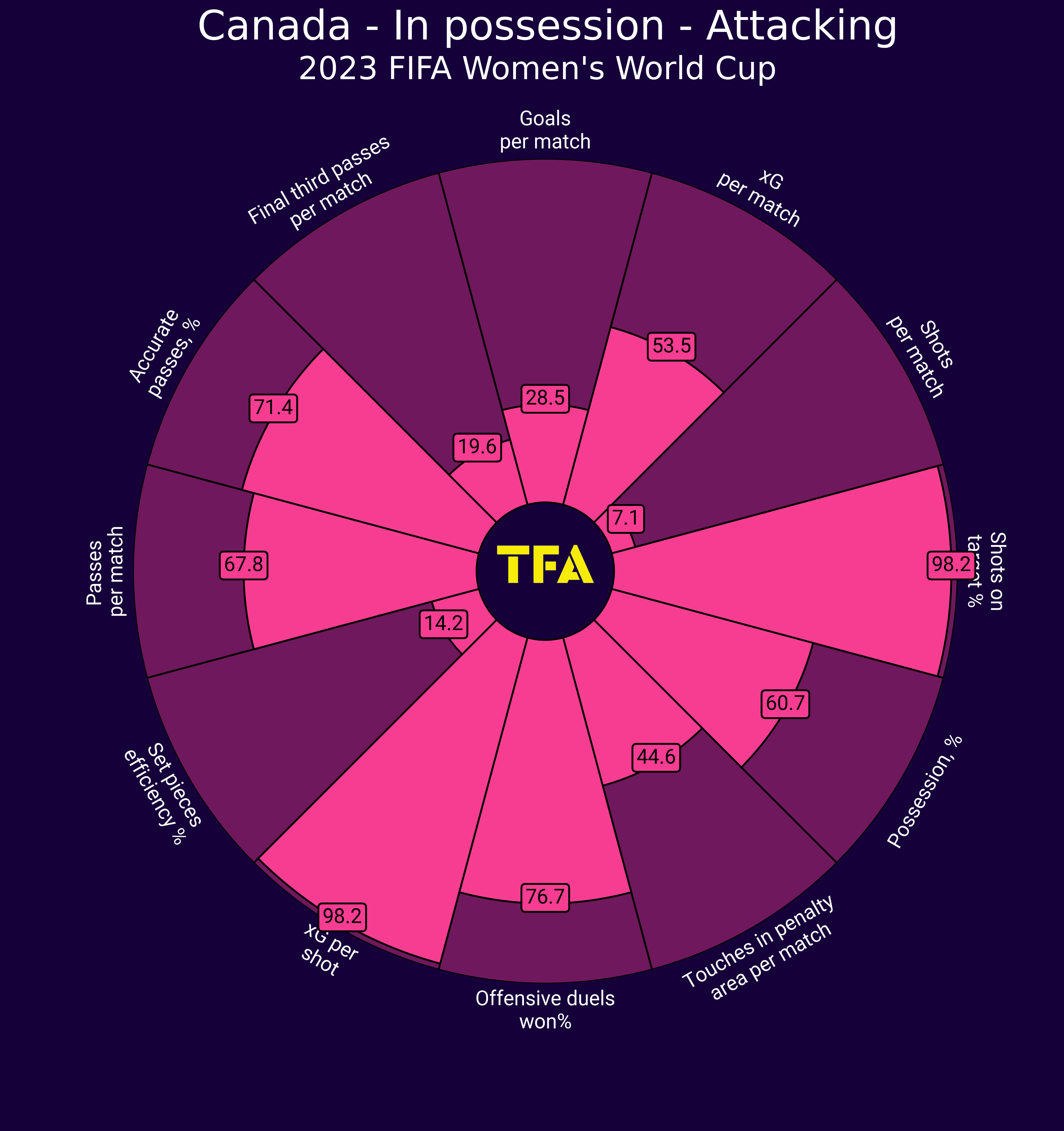
The pie chart graphic above shows how Canada looks to play in possession and how they look to attack and create chances under Bev Priestman. As we can gather from the graphic, Canada looks to hold the majority of possession in matches. Interestingly, they rank very low in the shots per match percentile but are one of the best national team sides when it comes to their shots on target percentage as well as their xG per shot. This shows that Canada are rather selective in front of goal, with them looking to only take shots on if they know they have a good chance of getting on target. This section will take a look at how Canada look to attack under Bev Priestman in more detail, showing fans what to expect come the World Cup in about a month’s time.
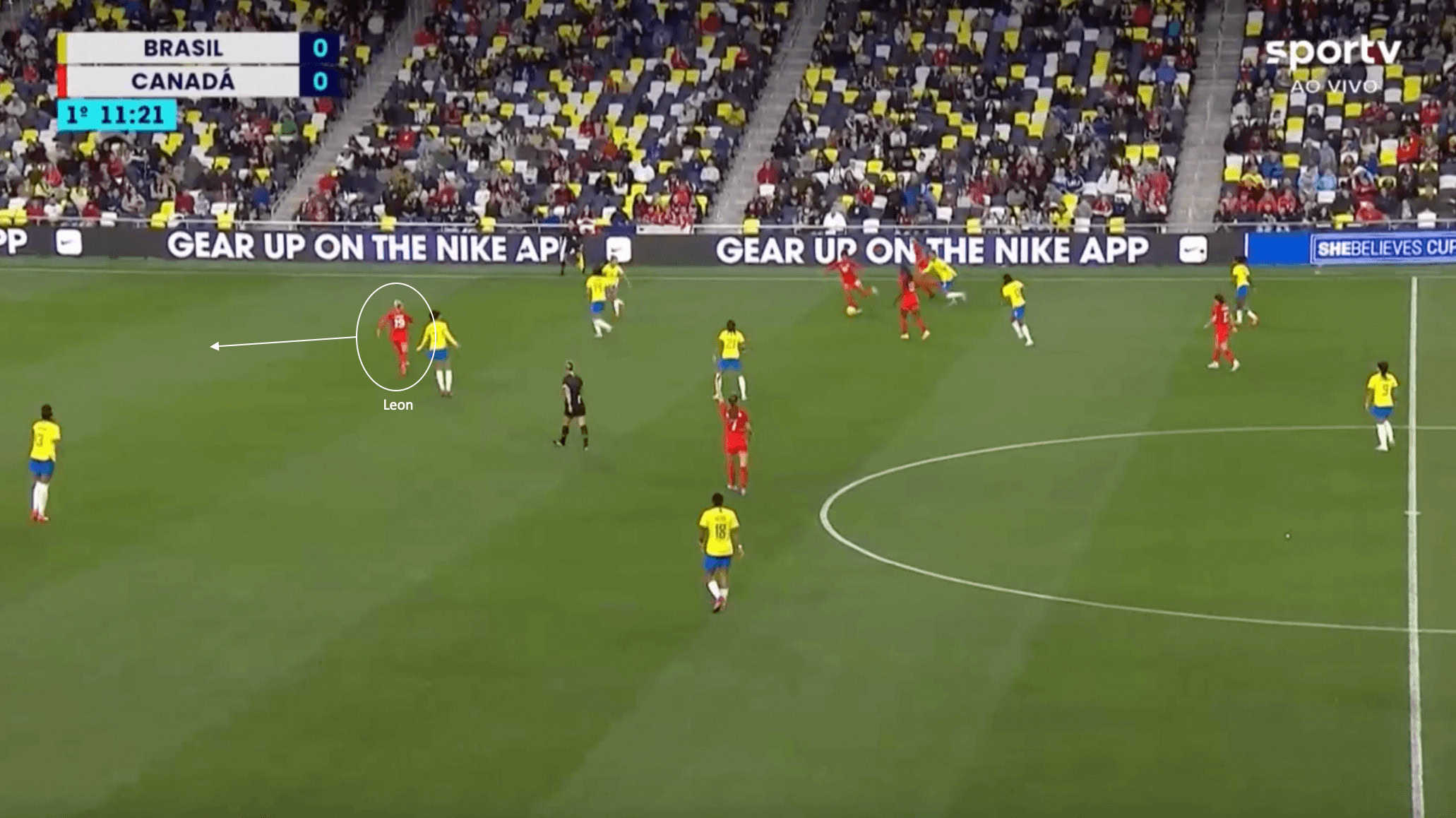
The image above shows an example of how Canada looks to attack and progress the ball forward. In the phase of play above from Canada’s recent match against Brazil in the SheBelieves Cup, the Canadians are in possession and progressing the ball into the attacking third. As the earlier pie chart graphic illustrated, Canada do hold the majority of possession throughout matches and look to play the ball around the defence and bide their time when it comes to progressing the ball into the opponent’s half. However, when they reach the opposition’s half, they look to catch the opposition out, with the Canadian forwards sitting on the shoulders of the last defenders looking to make runs in behind.
In the phase of play above against the Brazilians, we can see Adriana Leon’s positioning, with the forward sitting on the shoulder of the last Brazil defenders. As a result, the ball is played through to her into the space behind, with Leon able to drive through on goal and get a shot off, with the ensuing shot going out for a Canada corner.
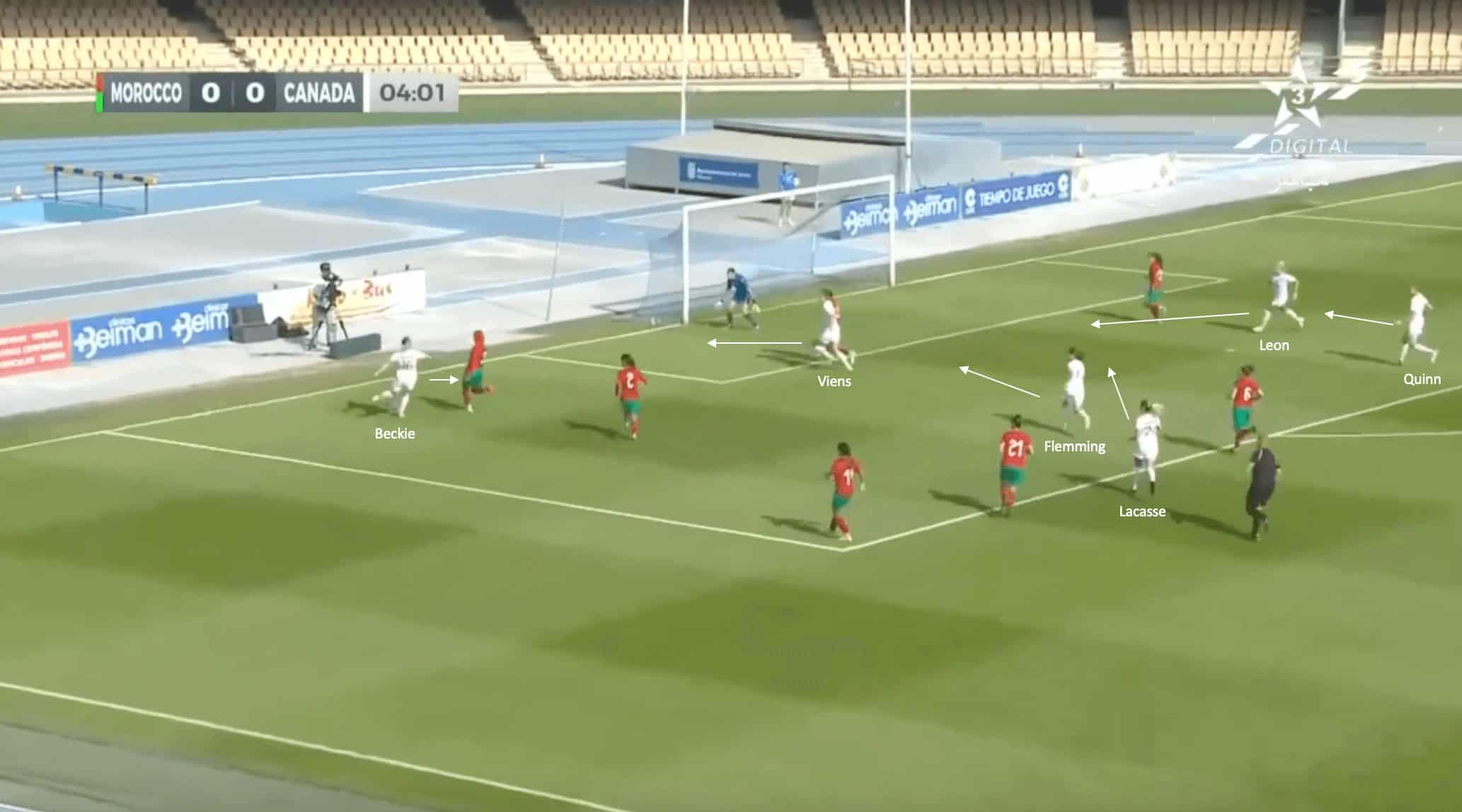
The image above shows how Canada look to utilise the wide spaces to send the ball back across goal and into the danger area to create chances. In this phase of play from a recent match against Morocco, Canada are able to shift the ball out to the wide area with Janine Beckie receiving possession and driving at the Morocco defender. In the central area, the Canadian side all collapsed into the penalty area, with their different movements looking to confuse the Moroccan defence and create space for a ball to be cut back into the box.
Evelyne Viens makes a move toward the front post area, with Jessie Fleming making a more central run from deep and Cloé Lacasse hovering near the edge of the penalty box. On the far side, Adriana Leon makes a run towards the penalty spot, with Quinn looking to make a run towards the back post. While the ensuing cutback pass from Beckie is blocked out for a corner, this example is able to highlight what Canada look to do to create clear-cut goalscoring chances, and why they have a low number of shots on target per match but a very high xG per shot.
Defensive phase

The pie chart graphic above shows how Canada play out of possession, looking at multiple different metrics to see how Canada look to defend under Bev Priestman. As we can see, Canada are a high pressing side under the 37-year-old, with them ranking very high in the pressing metrics. Under Priestman, Canada looks to counterpress when they lose possession, but they then tend to drop off and get into their defensive shape if they are not able to regain possession within a few seconds.
They do, however, rank high in aerial duels per match as well as defensive duels per match and xG against per shot. What this highlights is that in defensive moments, Canada look to drop off and drop into a defensive shape rather than look to put pressure on the ball and win back possession quickly, with them instead looking to absorb opposition pressure, which normally leads to plenty of shots on goal from opposition sides per match.
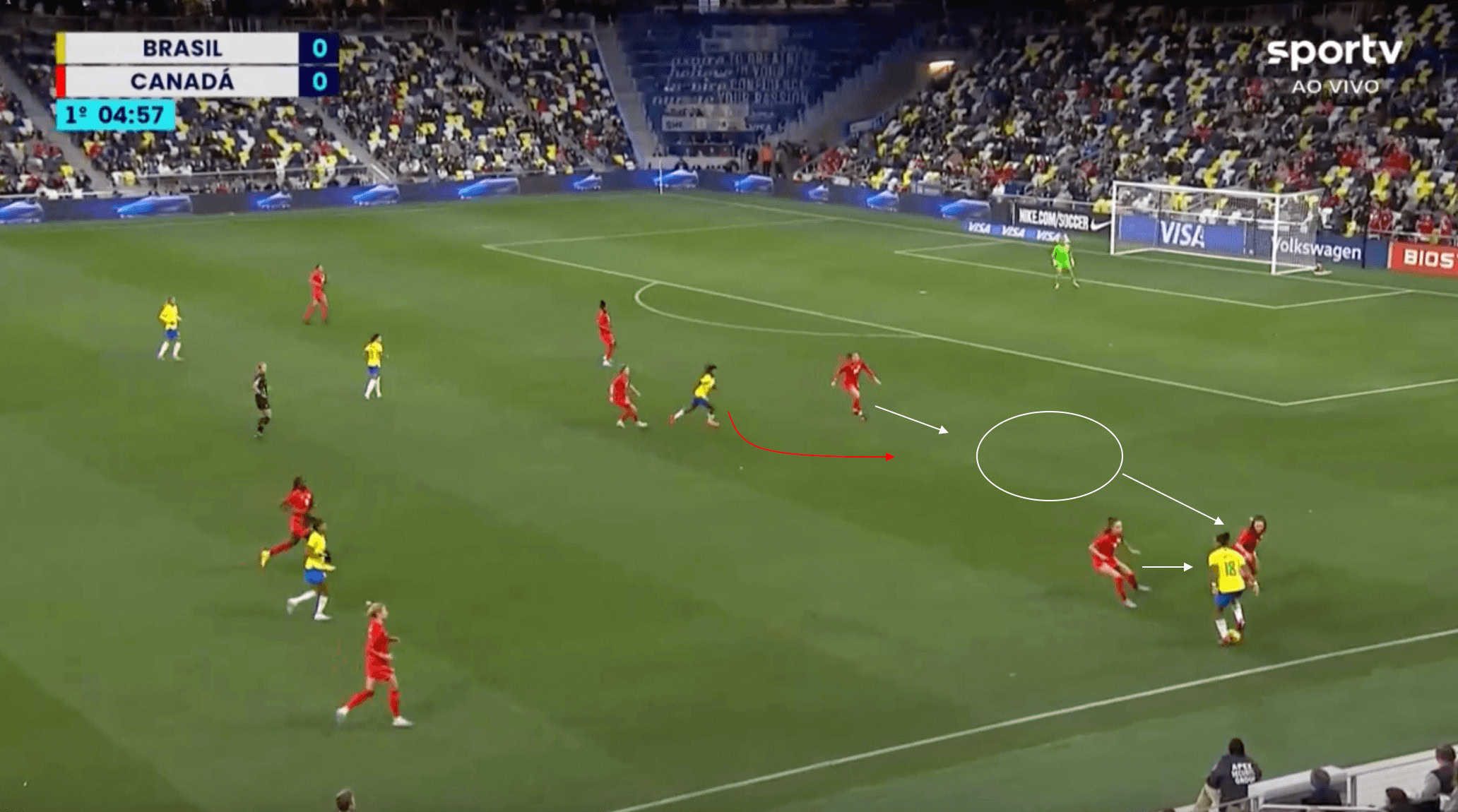
As the earlier pie chart graphic showed, from a defensive standpoint, Canada ranks highly in both their defensive duels per match as well as aerial duels per match. This phase of play above from the recent SheBelieves Cup match against Brazil puts this into more perspective. The Brazil winger is in possession and looking to drive at the Canadian defence. The full-back for Canada steps out of the backline to assist the wide midfielder in engaging the Brazilian attacker, with the right centre-back for Canada sliding over to cover the space and trying to intercept the run being made by the Brazilian attacker in the central area.
As a result of the movement of the central defender and the quick engaging of the full-back and wide midfielder, the ball is able to be knocked out of play by Canada, allowing the Canadian defence time to get back into position, as well as showing why the number of defensive duels that Canada attempts per match are in the top half.
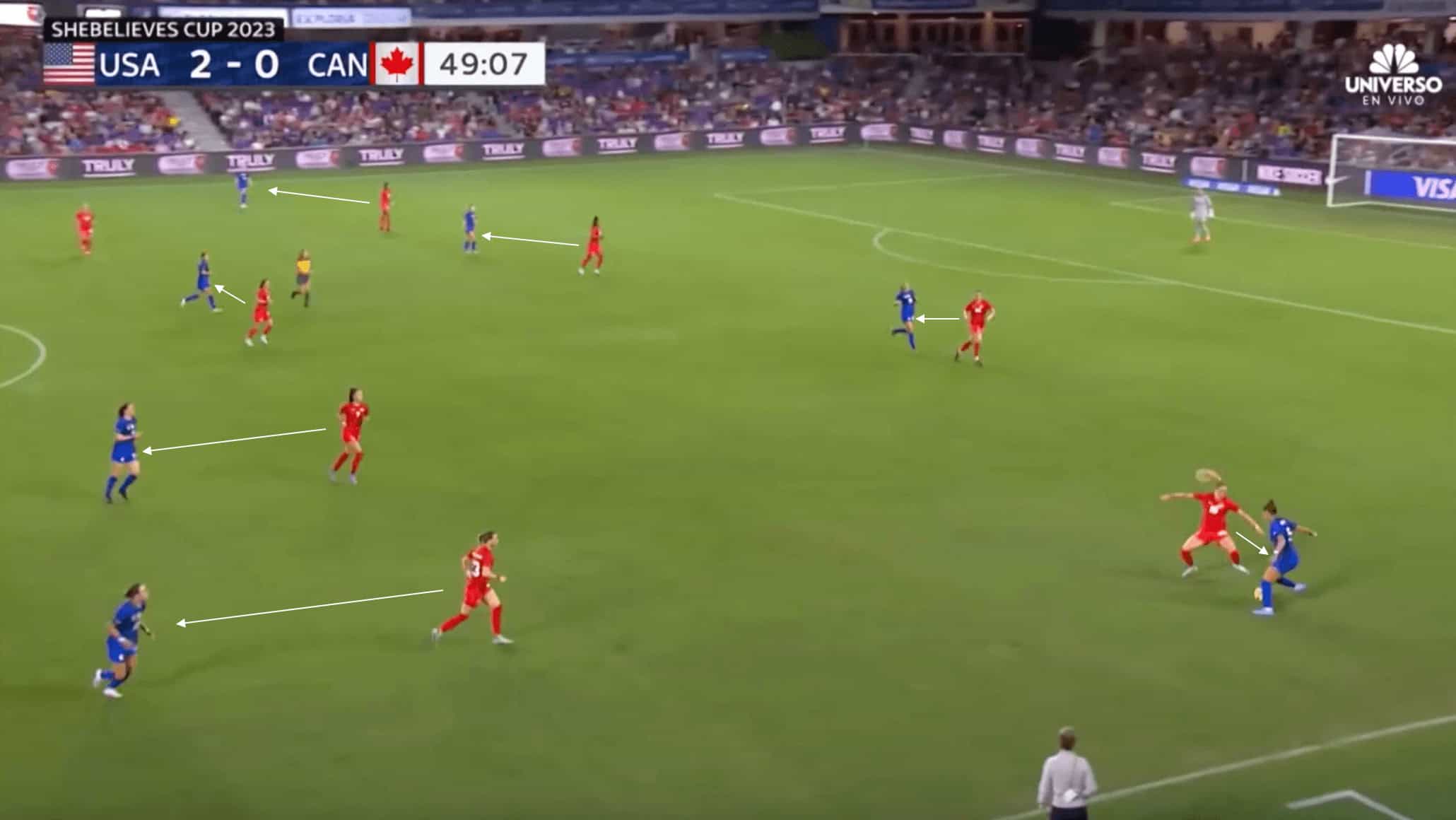
The image above shows how Canada look to defend, and this gives a little more insight into their high number of defensive and aerial duels per match, as well as high xG against and shots against. As this phase of play from their recent match against the United States shows, Bev Priestman’s side look to defend man-to-man across the pitch, a system that brings high risk and high reward. This defensive style depends also on individual defensive ability from the Canadian defenders, meaning that they have to have quality in both their defensive duels and aerial duels.
At this upcoming women’s World Cup, expect to see a Canadian side that mostly defends in a player-to-player system, with their positional rotations and covering of space key to how they like to defend. They will also likely give up a large number of shots due to how they look to defend, but when their individual defensive abilities shine through they are hard for opposition attacks to get through.
Transitions
When analysing Bev Priestman’s tactics with Canada during transitional phases of play, a common trend is Canada looking to counterpress to quickly regain possession and hit opposition sides with counterattacking moves. Canada’s transitional phase is really where their pressing shines through.
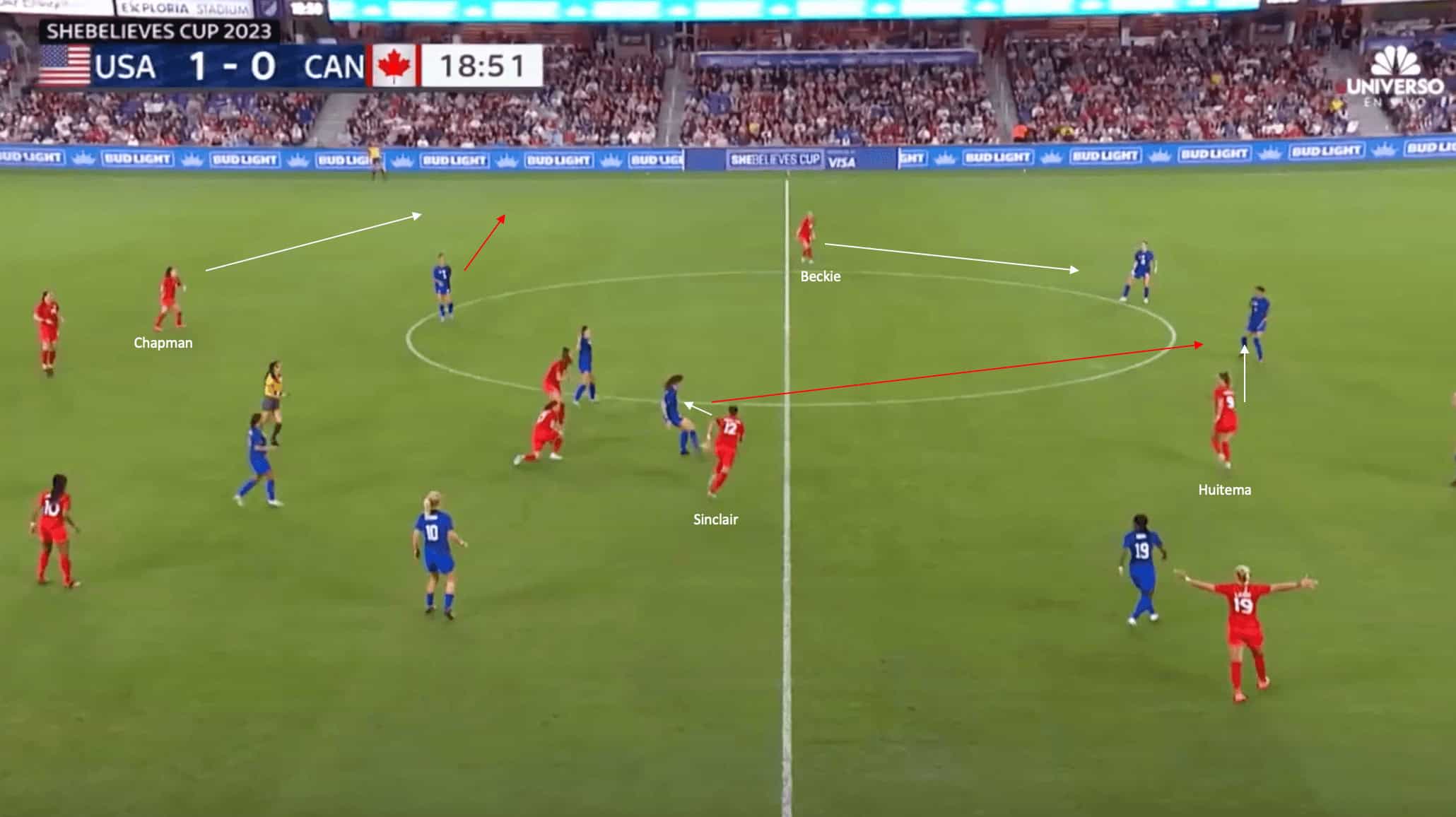
The image above shows a transitional phase from Canada, illustrating the pressure they put on the United States for the first few seconds after possession is turned over to attempt to regain possession in an advanced area.
After Canada turn over possession in midfield, the Canadian counterpress goes into action, with Christine Sinclair looking to put instant pressure on the USA midfielder. The ball is subsequently played backwards to the United States central defender, with striker Jordyn Huitema reading this pass and closing down to engage the defender.
Janine Beckie does this to the full-back as well, with Chapman also moving wide to pressure the United States winger who checks out to the wing looking to be an option for a pass. Unfortunately, the United States are able to play through this press, forcing Canada to drop off and assume their defensive shape as the ball is progressed forward.
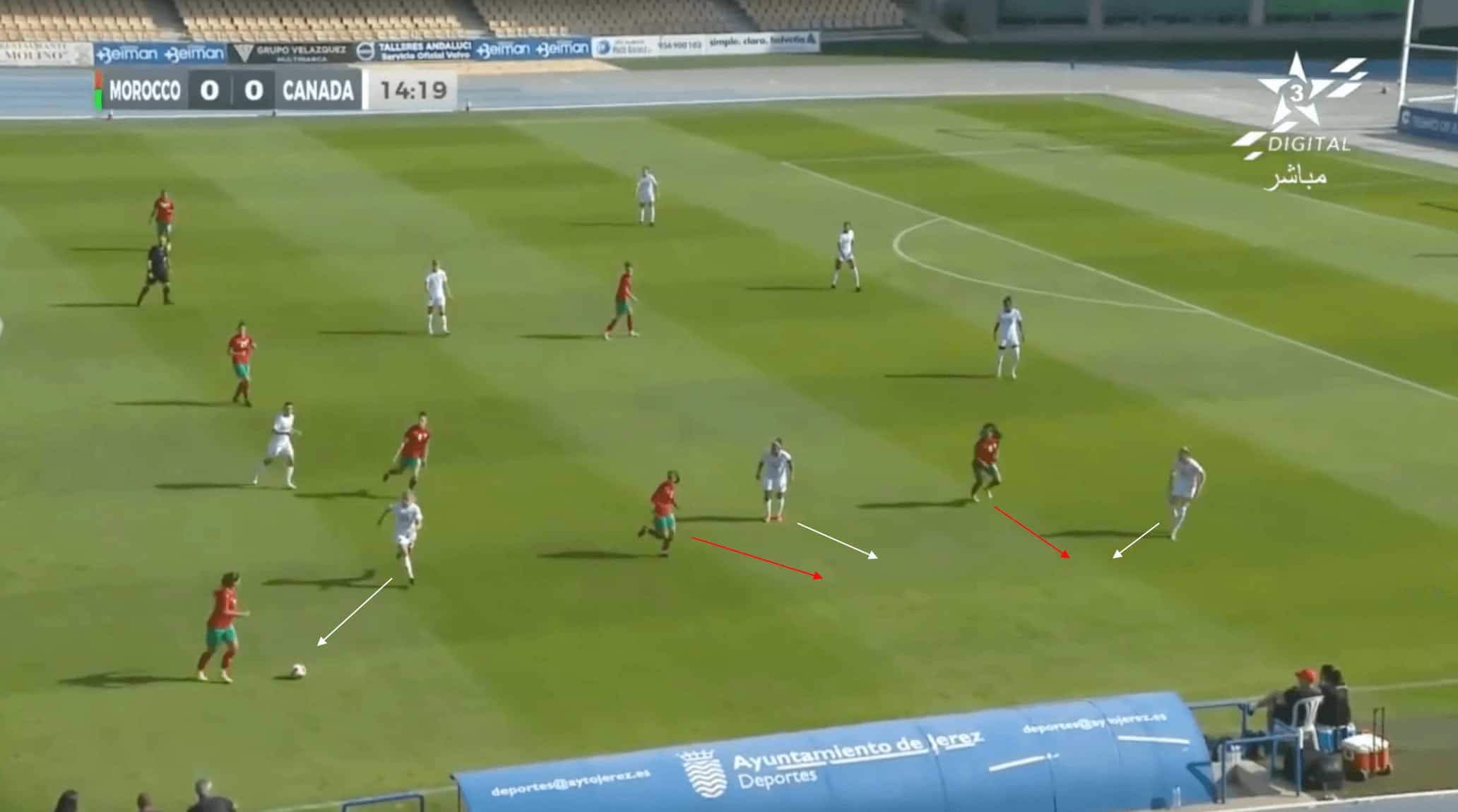
The image above shows another example of the transitional phase for Canada, with them looking to quickly win back possession through counterpressing after losing the ball to Morocco in their own defensive half. In this phase of play above, after the Morocco player gathers possession, she is instantly put under pressure by the Canadian forward, with the two closest Morocco players ahead of her also closed down and marked rather quickly. With no other option and the pressure coming quickly, the Moroccan player sends the ball forward, where the winger is not able to gather possession, allowing Canada the ability to win back possession and continue to build an attacking move.
At this edition of the FIFA Women’s World Cup, be sure to keep an eye on how Canada look to play in the transitional phase, with it not being a surprise if they look to counterpress to win back possession and continue attacking phases of play.
Attackers
When looking at the group of forwards that Bev Priestman brings into this World Cup, it is hard to look past the talent that is all along the front line. Jordyn Huitema will likely be the starting centre-forward for Priestman, with the 22-year-old in decent form at club level going into this tournament. Priestman also has some decent options to come off the bench this tournament, with Evelyne Viens scoring six goals in seven appearances at club level so far this term, and Clarissa Larisey having scored four goals this season for Häcken in the Swedish top flight.
The question marks for the forward positions are the health going into the tournament of both Nichelle Prince and Deanna Rose. The former comes into this tournament having just about fully recovered from a torn Achilles tendon. The latter suffered a similar issue, with Rose rupturing her Achilles on the first match day of the Women’s Super League back in August. For Canada, this attacking group will be an interesting one to keep an eye on, with this group having the potential to do special things this summer in Australia and New Zealand.
Midfielders
The group of midfielders at Canada’s disposal is again a group that many should keep an eye on, as it is hard to look past 40-year-old national team captain Christine Sinclair, who is playing in her last World Cup and is a monumental figure in the nation’s footballing history. Though in the past, Sinclair has been deployed as a striker at international level, she has been shifted back to a ‘10’ role to allow her a more passive, free-roaming part in the team’s setup.
Looking at the deeper-lying midfield positions, Priestman will likely look to start with Jessie Fleming and Julia Grosso, with this becoming the 37-year-old’s preferred double-pivot partnership in recent matches. This partnership will be responsible for progressing the ball forward, looking to find the Canada attackers further up the pitch. Looking at their passing accuracies, this should not be a problem. This season at international level, Grosso has a passing accuracy of 93%, while Fleming’s sits a bit lower at 80.8% — still a respectable number.
Moving forward, Adriana Leon and Cloé Lacasse look like they could be the two Priestman calls on in the more advanced midfield roles on either side of Christine Sinclair. These two also have respectable passing accuracies, with Lacasse sitting at 75.8% and Leon at a slightly lower 70.1%. There is also plenty of depth for this Canadian squad in midfield, meaning Priestman could even switch up the attacking midfield areas come the start of the tournament, with only really the triangle of Grosso, Fleming and Sinclair the likely nailed-down starters in this area.
Defenders
From a defensive standpoint, this will be an interesting group for Canadian fans and neutrals alike to keep a close eye on, with Priestman’s preferred defensive style leaving the backline exposed at times, with them having one of the highest xG numbers against of all the sides in this tournament.
The likely starting back-four will be Ashley Lawrence and Jayde Riviere in the two full-back positions, with Vanessa Gilles and Kadeisha Buchanan in the central defensive roles. As we saw earlier in the defensive pie chart graphic, Canada do have a high amount of defensive duels and aerial duels per match, and this will likely be where they stand out come their first match of the World Cup. Looking at the two full-backs first, Riviere wins just over half of her defensive duels per 90 minutes, while Lawrence sits at a very high 73.8% success rate.
When it comes to the centre-backs, both Gilles and Buchanan will be tasked with winning the majority of their aerial duels, with them looking to always be the highest in the air to balls sent into the box. At the international level, Buchanan wins, on average, about 67% of her aerial duels, while Gilles has an exceptional 80.4% aerial duel success rate in international competitions. Shelina Zadorsky also has the ability to slot into the starting XI should Priestman opt to drop one of the other two, with Canada having three very good central defenders at their disposal for this tournament.
Finally, in goal will be Kailenn Sheridan, with the 27-year-old making herself the undisputed number one for the Canadian national team in recent seasons. Barring some unforeseen circumstances, the San Diego Wave goalkeeper will be between the posts for Canada in their first match against Nigeria.
Key player
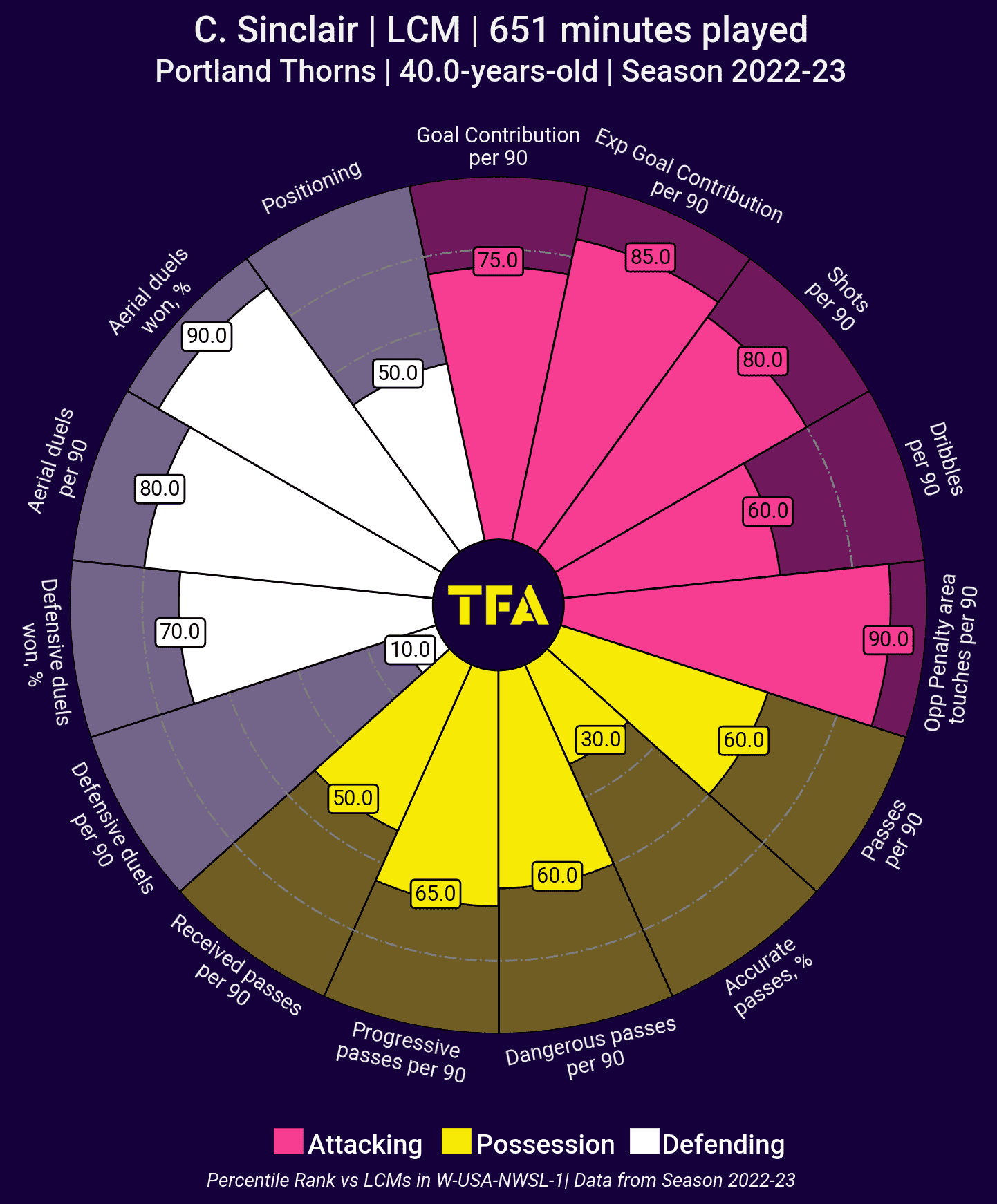
When it comes to talking about a key player for Canada in this upcoming World Cup, it is impossible to look past the impact that Christine Sinclair has the potential to have in what is her final World Cup. Looking at her attacking metrics first, Sinclair ranks in high percentiles for opposition penalty area touches per 90 minutes, shots per 90, and expected goal contribution per 90.
What this is able to show is that even at 40 years old, Sinclair still is dangerous in attacking areas, and will likely be looked at to create a good amount of Canada’s goals and chances at this World Cup. From a possession perspective, Sinclair has ranked fairly average in the passing metrics, showing that she still is an average to above-average playmaker in professional football.
Do not expect Christine Sinclair to be too involved in the defensive side of the game for Canada in this tournament. While her metrics show that she ranks highly in aerial duels per 90 minutes and aerial duel success rate, Sinclair will likely be solely responsible for creating chances for Canada going forward and trying to conserve her energy whenever possible. Even at 40 years old, expect Christine Sinclair to be a key player for Canada — and definitely, one that fans should be keeping an eye on throughout this World Cup.
Tournament prediction
For this World Cup in Australia and New Zealand, Bev Priestman’s aim should be to take Canada one step further than the 2019 World Cup in France, where they were dumped out of the tournament at the first knockout stage. She has a very talented and experienced squad at her disposal, and as this tactical analysis and scout report has shown, the 37-year-old England native’s tactics could be the x-factor for Canada to potentially be a dark horse in this tournament.

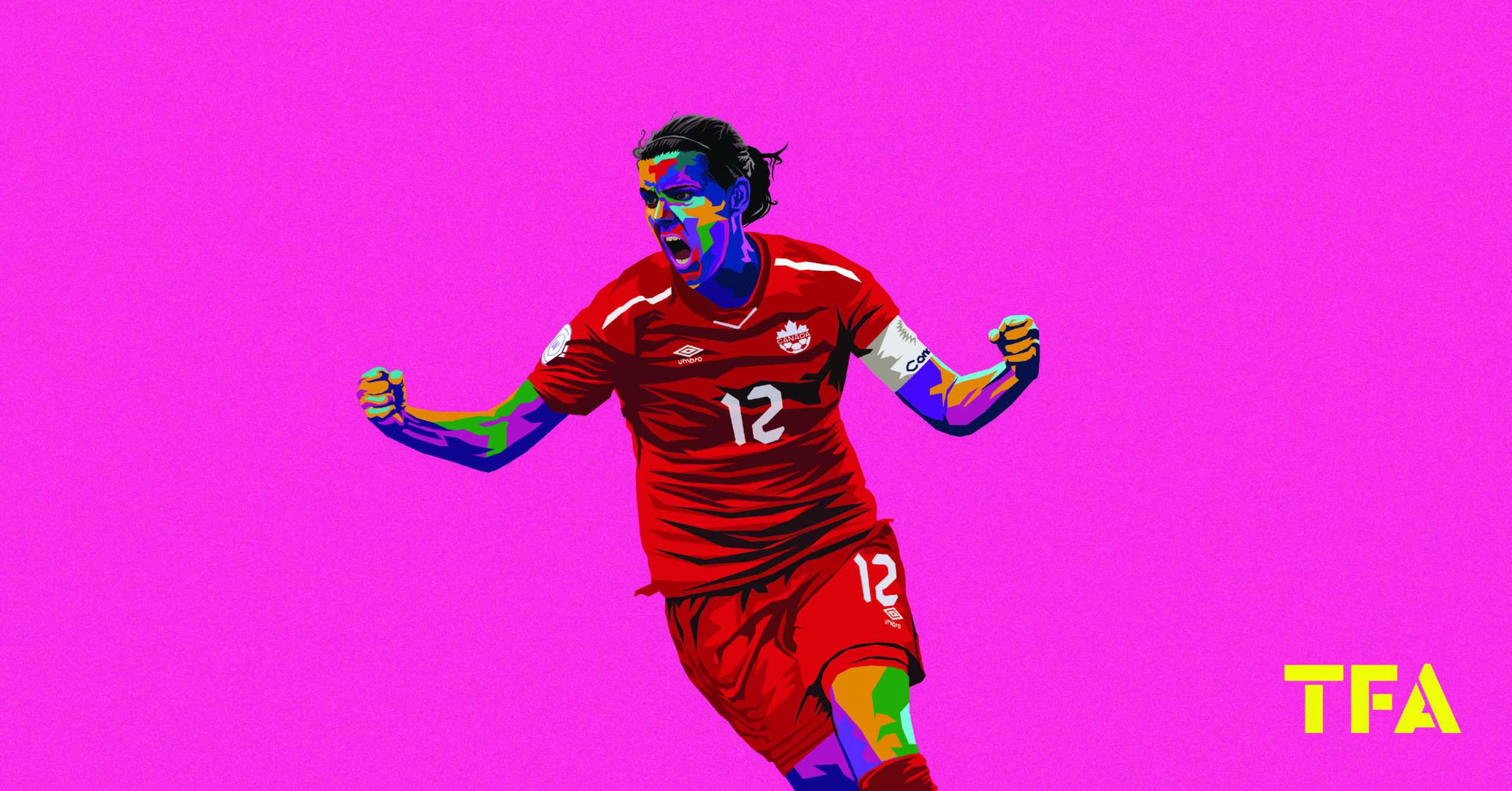



Comments